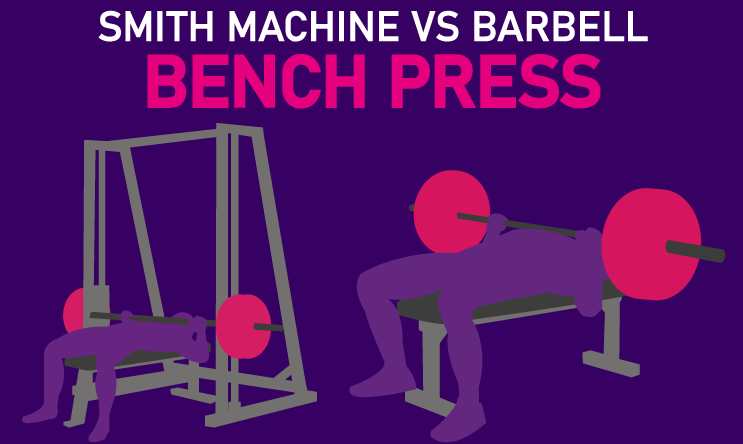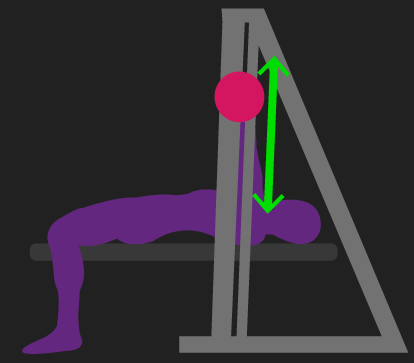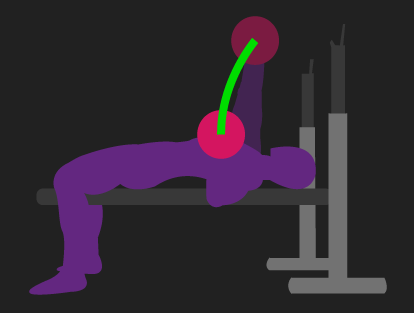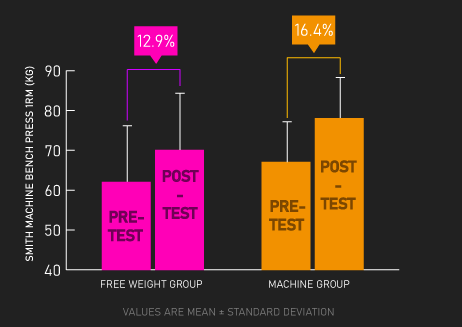
The bench press is one of the most popular exercises for developing the upper body.
Most often, people perform this exercise with a barbell.
However, there are numerous other modalities you can perform a bench press with, one of which is a smith machine.
It’s not hard to find individuals looking down on the smith machine, stating machines are worthless for serious lifters.
Generally, this is based on the premise that the smith machine is suboptimal for building muscle and strength.
But, is this true?
In this article, we’ll be using the research to evaluate and compare the smith machine bench press to the barbell bench press.
Table of Contents
Stabilization Differences
One of the most apparent differences between the smith machine and barbell bench press is the difference in stability.
When using a barbell, you have complete freedom of movement. Consequently, when carrying out a specific movement, such as the bench press, a fair degree of muscle stabilization and control is required.
Conversely, the smith machine does not enable completely free movement of the bar, only up and down motions. Resultingly, less muscle stability is required to carry out an exercise like the bench press.
For many, this stability difference is foundational to why they believe the smith machine is inferior.
It’s hypothesized the greater stability requirements provided with a barbell elicits greater activation of the working muscles, thereby making it a more powerful stimulus for strength and hypertrophy adaptations.
In a moment, we’ll verify these claims in the muscle activation and hypertrophy outcomes section.
Bar Path Differences
Aside from stability differences, both exercises can differ in bar paths.
With a smith machine bench press, your path is restricted to whatever the smith machine permits.
There exist different types of smith machines, but they typically only allow you to press with a more or less vertical line.

When viewing the smith machine from the side, some are designed in a way that results in a slightly diagonal up and down line.

Out of this, a difference between the barbell and smith machine bench press arises.
With a barbell bench press, most people:
1) Unrack that bar and initially place it over their shoulder line
2) Lower it to the mid/lower chest region
3) Push it back to over the shoulder line

When viewing the exercise from the side, this creates a much greater diagonal-ish up and down bar path than any smith machine would allow.
For the sake of being accurate, during the lifting phase on “hard” barbell bench press repetitions (when you are close to muscular failure), the most efficient lifting bar path involves pushing the bar back initially, and then straight up.

Anyway, one of the reasons why it’s likely not a great idea to use a vertical bar path (pressing straight up and down) with the barbell bench press relates to injury risk.
When initiating the lowering phase of the barbell bench press with the barbell directly over your shoulders, a straight bar path will ultimately result in your shoulders being abducted 90 degrees at the bottom position of the exercise.

Some research suggests that repetitive movements at 90 degrees of shoulder abduction could increase acute and chronic shoulder injury risk.
As a result, using a diagonal-ish barbell bar path (when viewing from the side) is favorable.
Now, with the smith machine, you are confined to a more or less straight bar path.
To avoid this injury risk position, you would want to start and initiate the lowering phase of the bench press with the bar over your mid/lower chest region. Not directly over your shoulders as you would with a barbell bench press.

Can You Lift Heavier On the Smith Machine or Barbell Bench Press?
It’s often thought that individuals should be able to lift much heavier loads on the smith machine.
After all, the smith machine involves fewer muscle stability requirements, meaning individuals should easily exert more force without stabilization problems.
Although this seems very logical, the research doesn’t actually support this.
The studies I’m aware of have either found that individuals could lift heavier loads on the barbell bench press, or there were non-significant differences in the loads lifted between the two exercises.
Correterman et al. found that in individuals with at least 1 year of training experience, they could barbell bench press an average of 78.3kg, while they could smith machine bench press an average of 67.4kg.
Similarly, Saeterbakken et al. found in men with an average of 4.6 years of training experience, barbell bench press one-rep max was statistically significantly greater compared to a smith machine bench press one-rep max. Unfortunately, they did not state the exact values, rather a graph that is pretty hard to decipher the precise value was provided.
Schick et al. found that in trained and untrained subjects, smith machine bench press one-rep max values were statistically similar to barbell bench press one-rep max values. Unfortunately, the exact values were not given.
Finally, Schwanbeck et al. found that in men and women with an average of 2.5 years of training experience, smith machine and barbell bench press one-rep maxes were also similar.
The men averaged a smith machine one-rep max of 88kg and a barbell one-rep max of 83kg.
The women averaged a smith machine one-rep max of 41.5kg and a barbell one-rep max of 39kg.
So in total, it seems that individuals are able to either lift heavier loads on the barbell bench press or a similar amount between the exercises.
Although the smith machine requires less stability, its constricted bar path could explain these findings.
As mentioned, with “hard” bench press repetitions, the most efficient lifting bar path appears to be one where you press back and then up.
With the smith machine, this is impossible, you are restricted with a less efficient more or less vertical bar path.
Smith Machine to Barbell Bench Press Carryover
How well does training the smith machine bench press increase your barbell bench press strength?
Also, what about the inverse of this, how well does training the barbell bench press increase your smith machine bench press strength?
Quite well, a study by Schwanbeck et al. finds.
We’ll detail this study more later on.
For this section, the relevant details are that they had two groups: a free weight and a machine group.
Both groups trained for 8 weeks.
The free weight group trained the barbell bench press and incline barbell bench press, whereas the machine group trained the smith machine bench press and smith machine incline bench press.
By the end of the 8 weeks, both groups actually experienced similar increases in barbell bench press one-rep max strength.

In other words, training the smith machine bench press was as similarly effective as training the barbell bench press for increasing barbell bench press one-rep max.
As for increases in smith machine one-rep max, although both groups experienced respectable gains, increases were greater for the machine group.

According to the principle of specificity (you get better at what you train the most), we’d expect the free weight group to have gained more strength on the barbell bench press (which didn’t happen – the machine group was similarly effective), while the machine group should have experienced the greatest gains on smith machine bench press strength (this did happen).
However, an important consideration is that this study was only 8 weeks in duration.
In the long run, I think it’s very likely the principle of specificity would hold true. That is, to gain the most strength on the barbell bench press, training it would be superior to training only the smith machine bench press.
And of course, as already shown in this 8-week study, training the smith machine bench press was required to best increase smith machine bench press strength.
Before moving on, if you’re curious about creating an effective training program for muscle hypertrophy, our high quality partner Alpha Progression can help. It can generate a highly effective program for you, track your workouts live with in-built progression recommendations, provide graphs displaying your long term progress, and it has a massive exercise database with more than 550 exercises.
Click HERE (the link opens in a new tab) to get a free 2 week trial of the apps features. If you like it and go beyond, the link also gives you 20% off a subscription!
We never promote trash at the House of Hypertrophy, so rest assured the app is high quality. The reviews speak to this, 4.8 starts (based on more than 7,000 reviews) on Google play, and 4.9 stars in Apple’s store (based on nearly 400 ratings).
Muscle Activation
Earlier we mentioned that it’s hypothesized the greater stability requirements provided with a barbell elicits greater activation of the working muscles.
However, for the main muscle groups involved in the bench press (chest, triceps, and front deltoids), the evidence does not support this.
Saterbakken et al. found that when measuring muscle activation during a one-rep max on both exercises, activation of the chest, front deltoids, and triceps was overall similar between a smith machine and barbell bench press.
Likewise, Schick et al. found that when subjects performed 2 reps at a 70% one-rep max load, or 90% one-rep max load, activation of the chest and front deltoids were similar between the smith machine and barbell bench press.
Farias et al. additionally found similar activation of the chest and triceps between the smith machine and barbell bench press. Interestingly though, activation of the front deltoid was greater in the smith machine bench press.
Nevertheless, the majority of the evidence indicates that the smith machine bench press can induce similar activation of the main muscles (chest, triceps, and front deltoids) to the barbell bench press.
However, for stabilizing muscles, the bench press probably results in more activation.
For instance, returning to the Saeterbakken et al. study, activation of the middle deltoid was greater with the barbell bench press.
This is likely because, with a barbell bench press, the middle deltoid plays a role in stabilizing the bar, whereas with a smith machine, this stabilization requirement is minimal (or even non-existent).
Hypertrophy Outcomes
Although there are some differences between the smith machine bench press and barbell bench press (like the bar path), there are way more similarities between these two movements.
Both exercises can involve a similar overall range of motion at the shoulder and elbow joints. Also, as established, both exercises produce similar activation of the main muscles (chest, triceps, and front deltoids).
Collectively, these two ideas suggest that the smith machine and barbell bench press result in similar tension on the chest, triceps, and front deltoids.
As mechanical tension is currently the best-understood mechanism of muscle hypertrophy, this indicates that both exercises should result in similar hypertrophy of the chest, triceps, and front deltoids.
Unfortunately, there is no long-term study comparing hypertrophy outcomes between smith machine and barbell bench press training.
But, there is one highly relevant long-term study by Schwanbeck et al.
36 subjects (15 men and 21 women) with an average of nearly 2 and a half years of training experience were assigned into a free weight or machine group.
For 8 weeks, subjects cycled two days of training with one day of rest.
For both groups, day 1 trained the chest, back, and triceps muscles while the second day of training worked the legs, shoulders, and biceps.
The programs for the respective groups can be seen below:

Both groups trained each exercise with 3–4 sets of 4–10 reps to failure.
Increases in thickness of the biceps and quadriceps (measured by ultrasound) were similar between both groups, indicating machines were as effective as free weights for muscle growth.

Unfortunately, chest growth was not measured.
Looking back at the programs used, we can see that both the free weight and machine group performed similar movements, it’s just the free weight group performed these movements with barbells and dumbbells, whereas the machine group performed them with machines (including smith machines).
Consequently, the study serves as pretty good evidence that smith machines have the potential to produce similar muscle growth to barbells, supporting the idea that a smith machine bench press should induce similar hypertrophy of the main muscles to the barbell bench press.
As for stabilization muscles, it’s plausible the barbell bench press would induce greater hypertrophy.
However, I don’t believe this is a strong reason for using the barbell over the smith machine for hypertrophy aims.
It’s extremely unlikely the stabilization muscles would be experiencing anything remotely close to a near maximal stimulus during a barbell bench press, ultimately making it inconsequential.
For example, as we detailed, the barbell bench press likely elicits greater activation of the middle deltoid to the smith machine bench press.
The stimulus provided to the middle deltoid via the barbell bench press is likely nothing compared to exercises that carry out the middle deltoid’s function (shoulder abduction).
Regardless of if you train with a barbell or smith machine bench press, exercises that involve shoulder abduction (like lateral raises variations) are going to be necessary to maximally develop the middle deltoid.
Remember to feel free to check out the Alpha Progression App if you’re interested. Also feel free to check out our free bench press e-book below.

